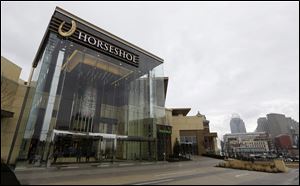
Horseshoe Casino Cincinnati to open doors today
Indiana, Kentucky officials bracing for the loss of tax dollars to Ohio
3/4/2013
Horseshoe Casino Cincinnati is a 400,000-square-foot facility built on a 23-acre former surface parking lot in the city core. It is the last of four casinos that Ohio voters approved in 2009.
CINCINNATI — With a glistening $400 million casino opening in Cincinnati today, officials and casino executives in two neighboring states are looking at the development with trepidation as they prepare to watch tax dollars flow into Ohio.
Horseshoe Casino Cincinnati is all but guaranteed to dip into Indiana’s casino revenues, which have steadily declined in the last few years.
For Kentucky, Cincinnati’s casino represents money that it could be, but isn’t, making.
The casino will open today after more than two years of construction. It will be the last of four casinos that Ohio voters approved in 2009 after a statewide campaign touted the immediate boost the casinos would give to Ohio’s economy.
Casinos in Cleveland, Toledo, and Columbus all opened over the last year and have brought in nearly $404 million combined. From that, about $133.2 million has gone to Ohio schools, counties, and cities.
Cincinnati’s casino is projected to draw about $227 million in gross revenue in its first year. That would bring in about $75 million in taxes.
Though those figures are far lower than earlier estimates, Cincinnati Mayor Mark Mallory hailed the casino as a regional and national destination ahead of its opening.
“It’s a home run,” Mr. Mallory said. “This casino will have the ability to draw people from all around the country. ... This is a top-line casino, and the people who are accustomed to the big casinos in Vegas, they're not going to miss anything here.”
Though no hotels are attached, and nothing quite compares to the energy or spectacle of the Vegas strip, Mr. Mallory referred to the Cincinnati casino’s bustling location on what used to be a run-down parking lot and ticked off amenities including a buffet, a VIP players’ lounge with high limits, a World Series of Poker room, and three outward-facing restaurants, including Jimmy Buffett’s Margaritaville and Bobby’s Burger Palace by celebrity chef Bobby Flay.
Both Mr. Buffett and Mr. Flay also have restaurant outposts in Las Vegas.
Across the state line in Indiana, casinos and state leaders have been bracing for the development.
“The hovering threat to Indiana’s dominance in commercial casino revenues among its sister states is evolving into reality,” Ernest Yelton, executive director of Indiana’s Gaming Commission, wrote in a 2012 annual report to Gov. Mitch Daniels. Nearly all of Indiana's 13 gambling venues would be affected, he added, “some dearly.”
Over the last two decades, Indiana’s casino industry has brought in $10 billion in taxes to become the state's third-largest revenue source after sales and income taxes.
But casinos there are in decline. Last year, taxes on casino revenues in Indiana dropped 4.2 percent, from $787.4 million in 2011 to $754 million in 2012, the steepest drop amid a three-year fall.
In the annual report, Mr. Yelton cited the economic climate, pointed to threats to Indiana’s industry from several neighboring states, including Michigan and Kentucky, and called Ohio’s new casinos the biggest challenge facing Indiana.
In Kentucky, Democratic Gov. Steve Beshear has tried and failed every year since his 2007 election to legalize casinos in the face of opposition from Republican lawmakers and a racetrack industry worried about competition.
At a news conference Feb. 21, Mr. Beshear lamented the opening of Cincinnati’s casino.
“The casino in Cincinnati’s good news for Ohio and bad news for Kentucky,” Mr. Beshear said. “Right now we’ve got thousands of Kentuckians that have been going out of state, and now they’ll also be going to Cincinnati to spend their Kentucky money in Ohio, and then Ohio’s going to keep the benefits of that.”